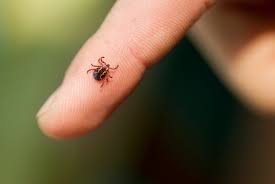 Warmer weather is on its way, which means that everyone needs to be doing their part to help prevent tickborne diseases. Providers reported over 1,400 cases of Lyme disease in 2018 (preliminary data as of 3/25/19). May is Lyme Disease Awareness Month each year in Maine—the perfect time to remind everyone to be “Tick Aware and Tick Alert” when spending time outdoors since ticks are most active in warmer weather.
Warmer weather is on its way, which means that everyone needs to be doing their part to help prevent tickborne diseases. Providers reported over 1,400 cases of Lyme disease in 2018 (preliminary data as of 3/25/19). May is Lyme Disease Awareness Month each year in Maine—the perfect time to remind everyone to be “Tick Aware and Tick Alert” when spending time outdoors since ticks are most active in warmer weather.
Lyme disease is treatable and most individuals recover completely with proper treatment, however easiest way to avoid tickborne diseases is prevention. This May please remember to be
“Tick Aware and Tick Alert”:
1) Use caution in areas where ticks may be found;
2) Wear light-colored clothing that covers arms and legs;
3) Use an EPA approved repellent such as: DEET, picaridin, IR3535, and oil of lemon eucalyptus; and
4) Perform tick checks daily and after any outdoor activity on yourself and pets. Taking a shower after exposure to a tick habitat is an effective way to wash off any unattached ticks and provides a good opportunity to do a tick check.
Lyme disease is caused by a bacterial infection that is passed through the bite of an infected deer tick. Adults over the age of 65 years and children between the ages of 5 and 15 years have the highest rates of the disease in Maine. Individuals that work and play outside are more likely to be exposed to ticks. Ticks must be attached for 24-48 hours before they can transmit the bacteria that can cause Lyme disease. Proper tick checks will allow you to find and remove ticks before getting Lyme disease.
If you are bitten by a tick or spend a lot of time outdoors, make sure to monitor for symptoms for up to 30 days after exposure. Also be sure to call your healthcare provider if symptoms develop. The most common symptom of Lyme disease is a skin lesion called erythema migrans (EM), better known as the “bull’s-eye” rash. This usually appears 3-30 days after the tick bite. Other symptoms include fever, headache, and joint or muscle pain.
Lyme disease is not the only disease that can be carried by deer ticks in Maine. Anaplasmosis, babesiosis, Borrelia miyamotoi, and Powassan are other tickborne infections found in Maine. The number of provider-reported human cases of anaplasmosis, babesiosis, and Powassan decreased in 2018 while reported cases of Borrelia miayamotoi increased slightly. All four remain a public health concern for the Maine Center for Disease Control and Prevention (Maine CDC).
While the deer tick is the only species of tick in Maine that can pass the bacteria that causes Lyme disease, there are a number of other species of ticks found across the state. Tick identification is important, especially when removing ticks. There are tick identification resources available to order at the Maine CDC website. The University of Maine Cooperative Extension Tick ID Lab also offers identification and testing services as well as educational references.
Resources:
Maine CDC has Lyme disease information available at http://www.maine.gov/lyme
Lyme disease data is available through the Maine Tracking Network at http://www.maine.gov/lyme under EPI Information on the left hand side of the page.
University of Maine Cooperative Extension Tick ID Lab submission instructions can be found at http://extension.umaine.edu/ipm/tickid/
For additional questions, please call Maine CDC at 1-800-821-5821 or email disease.reporting@maine.gov
Tickborne videos can be found at https://www.maine.gov/dhhs/mecdc/infectious-disease/epi/videos.shtml